PRESIDENT'S COMMENTS
Urban sprawl has reared its ugly head again (Will it ever go away?). When I look back on my past President's Comments that have appeared in this newsletter, preservation of woodlots was a recurring topic of discussion. The Irish Grove Woodlot in Grimsby and the Thundering Waters Forest in Niagara Falls have both been greatly debated at municipal, regional and public meetings.
Now the Waverly Woods is threatened. The 14 hectare private woodlot adjacent to Waverly Beach Park in the Town of Fort Erie is slated for development. The woodlot provides a natural setting for many residents in Fort Erie to enjoy and a home for a variety of wildlife. If development takes place, will the Red-headed Woodpeckers continue to nest in the area? What will happen to the migratory birds that rely on this stop-over before continuing on to their breeding grounds further north? Foxes that raise their young will surely feel the pressure and leave the area.
At our November Annual General Meeting, Loretta Shields' presentation, "Trees: Our Warriors Against Climate Change", demonstrated that trees are essential in reducing carbon dioxide in our atmosphere. If we continue to cut down significant woodlots without a thought on how it will affect future generations, the slippery slope just gets steeper.
Regards, Bob
Lyndsay Schram, Sept. 26, 2017: "Lichens and the Environment"
Our speaker for the evening, Lyndsay Schram, is a student at the University of Guelph, working with professor Troy McMillin, and studying the general aspects of the growth of lichens and where they can be found – which is "everywhere" (as Lyndsay explained them). Indicating the presence of lichens, Lyndsay stated that there are about 17,000 species of lichens known atthe current time.
To explain the organisms that she studies, Lyndsay said that in general a "lichen" is an organism that is made up of a fungus and an alga. However, a lichen may also partly include an cyanobacterium, so that three different organisms (fungus, alga, bacterium) may make up a lichen. She pointed out that some people call lichens “mosses’, although a lichen is not actually a moss. However some people are aware of a mossy organism that they call "Reindeer moss", which is actually a lichen and is an important food for the northern "Reindeer" or Caribou species.
The studies of lichens may be involved with various other scientific studies, such as the determination of glacier aging, studies of species and development of trees, and such odd items as determining the types of gasses from the Coniston Smelter in Sudbury by determining the lichens in the area. Explaining further about the appearance and locations of lichens, she mentioned that the connection of fungus+alga+cyanobacterium may develop into an organism that may be "thread-like", or flat like cloth, or appearing like masses of stones clumped together, or appearing like mushrooms on stalks. They may be seen on trees, on stone, wood, leaves, moss and dead vegetation, and on animal parts such as deer horns, bones, etc.
(Your writer was unable to capture all of the details of Lyndsay's talk, partly from the difficulty of note-taking in a dark room. However, I can lend you a book, "Lichens of North America" by Irwin Brodo et al, 800 pages and 8 lb. weight, which will increase your knowledge of this fascinating topic.)
Owen Bjorgan, Oct. 23, 2017: "The Bruce Trail"
Our speaker tonight thought of doing a long hike and
really did it...
Owen Bjorgan grew up in Queenston, and went hiking on parts of the Bruce Trail many times as he was growing up. In 2014 he decided to hike the entire Bruce Trail to raise money for charity. As the result of his endeavour, he spent 37 days in May on the Trail, and raised $27,000 for youth with disabilities and conservation in Niagara. While on the Trail, Owen walked an average of 33 km per day and rested 10 hours, sleeping in a tent overnight. Starting out at the Tobermory end of the Trail at the end of April, the weather proved to be cold with snow on the ground, and on several areas he found there was standing water covering the trail. As for his system for nourishment, he carried a filter to provide drinking water, and the trail went close enough to stores for him to keep supplied with food. As he neared the Queenston end of his hike, his family joined him on the trail, giving him a mental boost at the end of his trek.
Lorettta Shields, Nov. 27, 2017: "Trees – Warriors Against Climate Change"
Our speaker, Loretta, lives near Smithfield, in an area which, up until a few years ago, was prime farming land. Recently, in that area, during the construction of numerous electricity-generating windmills, the work-crews removed literally thousands of trees to make space for the windmills. Since Loretta is employed by Agriculture Canada and is also a member of Ontario Woodlot Association, she became curious about how much damage to the ecosystem would be the result of the carelessness of the construction crews. Her calculations of the damage were shocking. First, though, Loretta reminded us of the importance of trees, in carbon sequestering and releasing oxygen, in retaining soil and decreasing soil erosion, in modulating air temperature, and a variety of human uses for wood. Her speech-title "Warriors Against Climate Change" made her point that trees are a defence against the rising temperature that threatens all living creatures, and thus seeing wanton destruction of trees irritates her. In our next PFN Newsletter, there may more detail of Loretta's presentation.
Biggar Lagoons Outing (Grimsby Lagoons)
On Saturday, June 10, we added the Biggar Lagoons to our growing list of PFN outing locations; thanks to Rick Young and Carol Horvat for leading the group. The former sewage Lagoons have been transformed into a beautiful wetland complex, complete with a viewing platform and observation blinds. Anyone who used to bird here before the renovations can tell you that this is a huge improvement over climbing the rickety wire gate and trudging through the waist high grass to try to find an opening in the foliage through which to observe wildlife on the ponds. Some of the notable birds we found were Ruddy Duck, Eastern Kingbird, Willow Flycatcher, Marsh Wren and Common Tern. It is also a good area to see butterflies and other insects. We will be returning to this location for another outing on June 10, 2018.
Enjoying Nature in the City, Thursday, June 20, 2017
Our annual walk across the pedestrian bridge from Jaycee Park to Rennie Park in Port Dalhousie has become to be known as the "Ice cream Walk" because we make sure to stop for a cone at the halfway point. Along the way we observe the birds and wildlife that call Martindale Pond home. We were happy to see the Barn and Cliff Swallows successfully nesting underneath the bridge. We also watched a Mink as she hunted along the stoneworks of the old canal. It is such a lovely place for an evening stroll.
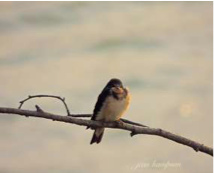
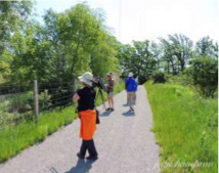
PFN Picnic, June 25, 2017
The PFN Annual Picnic again took place at the Pavilion on Merritt Island Park in Welland, on Sunday, June 25 from 10:00 am to 3:00 pm. Thanks is due to Roman Olszewski for arranging for the use of the Park. Fortunately, there was no problem about rain, but on the other hand, the day also happened to be the Welland Rose Day parade, which made traffic to the Park a bit problematic. Before the noon lunch, Pres. Bob led a tour of the Park, not finding any weasels this time, but helping about 20 picnic-goers to develop an appetite before lunch.
Norfolk County Mushroom outing.
On Saturday, September 30, we ventured outside of the Niagara Peninsula to travel to Backus Woods. There we met up with Inga Hinnerichsen, who is the President of the Norfolk Field Naturalists. She is also a lifelong Mushroom enthusiast. She introduced us to some identification techniques and demonstrated the making of spore prints (see rt. photo). Then Inga led a hike through the woods, pointing out the various types of fungi along the trail. Since it had been an unusually warm autumn, not many ground mushrooms were up but we had plenty to see growing on trees. They included Tinder Polypore, Mossy Maple Polypore, Shimeji, Purple Toothed Polypore, Turkey Tail and Shelving Tooth. We found some nice little Puffballs (l. photo) that were puffing out spores and a Comb Tooth that resembles a piece of Coral. It was an extremely interesting hike and we thank Inga for leading it for us.
After a picnic lunch by the lake in Port Rowan, we journeyed to the Bird Studies Canada property to search for birds. They were holding their AGM and they graciously invited us to attend but we had our minds set on locating birds. We found at least 600 American Coots on the lake. We also went to the overlook at Big Creek before heading home. It was a very enjoyable day. (Photos by Jean)
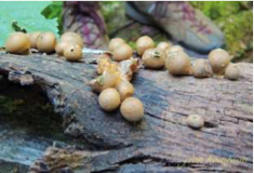
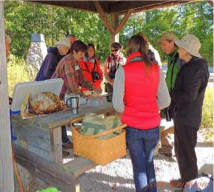
Mud Lake Conservation Area Outing, 2017
On Saturday, October 21, Jean Hampson and Bob Highcock led an outing at Mud Lake Conservation Area. Once again, PFN members hiked around the perimeter of Mud Lake. The annual hike along the Blue Heron Trail has been enjoyed by club members since 2014.
Waterfowl were scarce with only Mallard and Canada Goose observed on the open water. Two American Coots were seen in the reeds at the north end of the lake as a Northern Harrier patrolled the air above. Woodpecker species observed during the 2.5 hour walk included Red-bellied, Downy, Hairy and Northern Flicker. In total, 24 bird species were seen. Frogs and Red Squirrels also made an appearance and the junipers were full of berries (Note the photo!).
It was a beautiful fall day for the outing. The only downside was that not all of the group was lucky enough to observe rare Corvids flying above Elm Street. After others from the group had left the area, Jean, Bob, Carol and Doug viewed two Common Ravens from the shoulder of the road that is adjacent to the conservation area. Raven observations seem to be occurring more and more in the Niagara Region. With a little bit of birding luck thrown in, hopefully we'll have a repeat appearance for the entire group during next year's outing to Mud Lake.
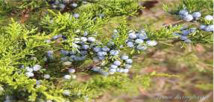
Glenridge Quarry Naturalization Site Outing 2017
OnSunday,October 29, the Peninsula Field Naturalists visited the former municipal landfill, now known as the Glenridge Quarry Naturalization Site. It was a good day for a fall hike on the Loop Trail. Our group observed a total of 17 bird species. Highlights included a Great Blue Heron acting as the pond sentry, Red- bellied Woodpecker, both species of kinglet, House Finch and two Fox Sparrows that provided excellent views for all in the group. By Pres. Bob
In Search of the Purple Sandpiper, Sunday, November 5, 2017
John Black led the 6th annual outing along the east pier in Port Weller on Sunday November 5. This year, grey clouds hung over the Port Weller area and a light rain fell at times. Due to the wet weather and with the permission of the St. Lawrence Seaway Authority, the small group of participants travelled in two cars along the gravel road on the East Spit. Despite the precipitation, we were all eager to see a Purple Sandpiper.
Along the shoreline, we encountered a flock of Snow Buntings and had good looks at them when they landed on the footpath. Species observed on the lake included White-winged Scoter, Common Goldeneye, Red-breasted Merganser, Long-tailed Duck and Common Loon. We scanned the rocks on the lake side and bay side of the spit but there were no shorebirds found.
Returning to the canal, our group looked at the gulls and buntings at the end of the east pier. Then, out of the purple, err blue, a stout, dark-bodied shorebird flew across the canal entrance and quickly disappeared behind the lighthouse on the west pier. This year, everyone in the group had a quick look at the bird flying across the canal. We were quite certain it was the shorebird we were looking for. Studying images of basic plumaged and first year birds later that day, confirmed we had seen a Purple Sandpiper.
Before leaving the East Spit, we checked out the pond and observed Bufflehead, Mallard, American Black Duck and one Green-winged Teal.
We must have been in a happy mood because we agreed to do some additional birding on the west pier. We could not relocate the Purple Sandpiper observed from the east side but we had great views of an adult Bald eagle as it flew above us.
Before concluding the outing, we had one more stop. We checked out the piers and the break walls at the Port Dalhousie Yacht Club. Sightings at this location included Great Black-backed Gull, Herring Gull, Ring-billed Gull and a flock of Dunlin flying low over Lake Ontario.
A successful trip this year! Thanks to John Black for leading the outing!
Passing of Peter Stephani
The members of the PFN have lost a long-time member, namely Peter H. Stephani, who passed away on November 1, 2017, aged 91, after a result of pneumonia. Peter was a true naturalist, being a member of both the PFN and the NFNC, as well as the Bruce Trail Club. It was said that he was active in the Bruce Trail Club until advised by his doctor to stop. As an example of his enthusiasm, on Jan. 4, 2009, hiking the Bruce Trail on the Niagara Escarpment, the icy slopes and icier weather forecast didn't deter Peter Stephani and 20 other determined winter hikers on Sunday. "You just have to be careful. No running, eh?” That comment was typical of Peter’s approach to life. As a legacy to the Nature Clubs, as an artist, in 1972 Peter designed the Niagara Falls Club logo of a gull flying over Niagara Falls. Peter also designed the PFN crest, centering upon the Comfort Maple, with a fish below and two gulls above, thus the symbols denoting water, earth and air.
After the moving...
After three PFN fall meetings in our new meeting location, in Room 4 of the Niagara Region Headquarters building, at 1815 Sir Isaac Brock Way (formerly 2201 St. David's Rd), the members who have attended the meetings have found the new location suitable. Car-parking is sufficient and free. The room for the speaker's presentation is acceptable and free (although the long central table is a novelty!). Our first speaker, while setting up for her presentation, found that the projection screen was missing . However, the wall made a suitable 'screen' – so no problem there. The "kitchen" has adequate room for the snacks, and for waste-disposal.
As explained, we use Room 4, on the main floor of the headquarters building, to the left when you enter the main doors of the building. The PFN Board will provide you with further news about our new situation, if any changes arise.
Information of Bird Counts for Niagara Area
PFN Count: December 17 - contact Bob Highcock – 905-688-1260
Niagara Falls Christmas Bird Count – December 27 – contact Marcie Jacklin – 905-871-2577
Port Colborne Christmas Bird Count – Saturday, Dec. 30 – contact Drew Campbell – drew.campbell@gm.com -meet at McDonalds Restaurant, 589 Main St. West
Water-fowl (Duck) Count – January 7, 2018 – contact John Black – black@brocku.ca
Grimsby Peach Tree Christmas Bird Count – Bruce Mackenzie (contact Bob Highcock for Bruce's phone-number....)
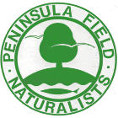
The Peninsula Field Naturalists Club
A non-profit organization started in 1954 with the objectives to preserve
wildlife and protect its habitat, to promote public interest in and a knowledge
of the natural history of the area, and to promote, encourage and cooperate with
organizations and individuals having similar interests and objectives.
Affiliated with Ontario Nature and Nature Canada.
P.O. Box 23031, RPO Carlton, St. Catharines, ON. L2R 7P6
Website : peninsulafieldnats.com
The Peninsula Naturalist
Published: February, April/May, October/November
The Editor welcomes written articles or artwork on any natural history topic.
Please submit typed reports on paper or by email to: jmpotter068@gmail.com
Colour photos (jpg) accompanying articles are welcome. All pieces of artwork
will be accepted. New ideas and constructive criticism are welcome. Please send
submissions by email to e-address above, or by snail-mail to the Club’s postal
address.
Editor: John Potter
Assistant: Mary Potter
–
The Peninsula Naturalist Newsletter,
Published: February, April?; October/November
Download the complete newsletter pdf
